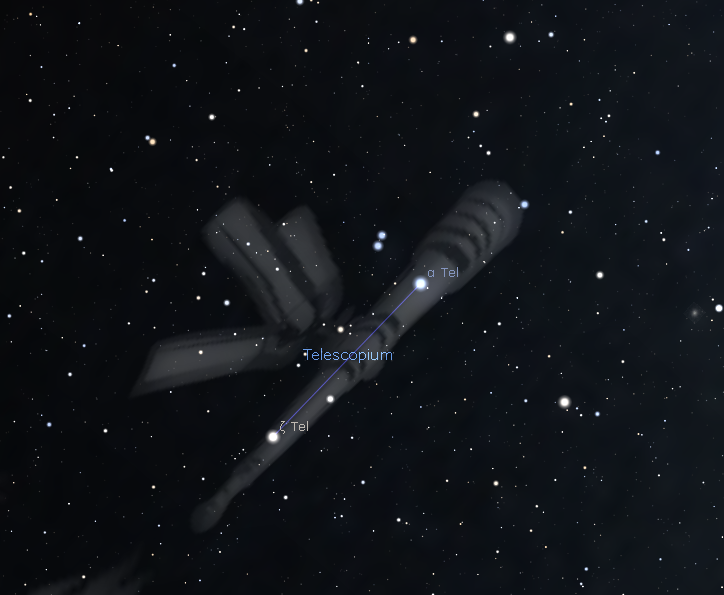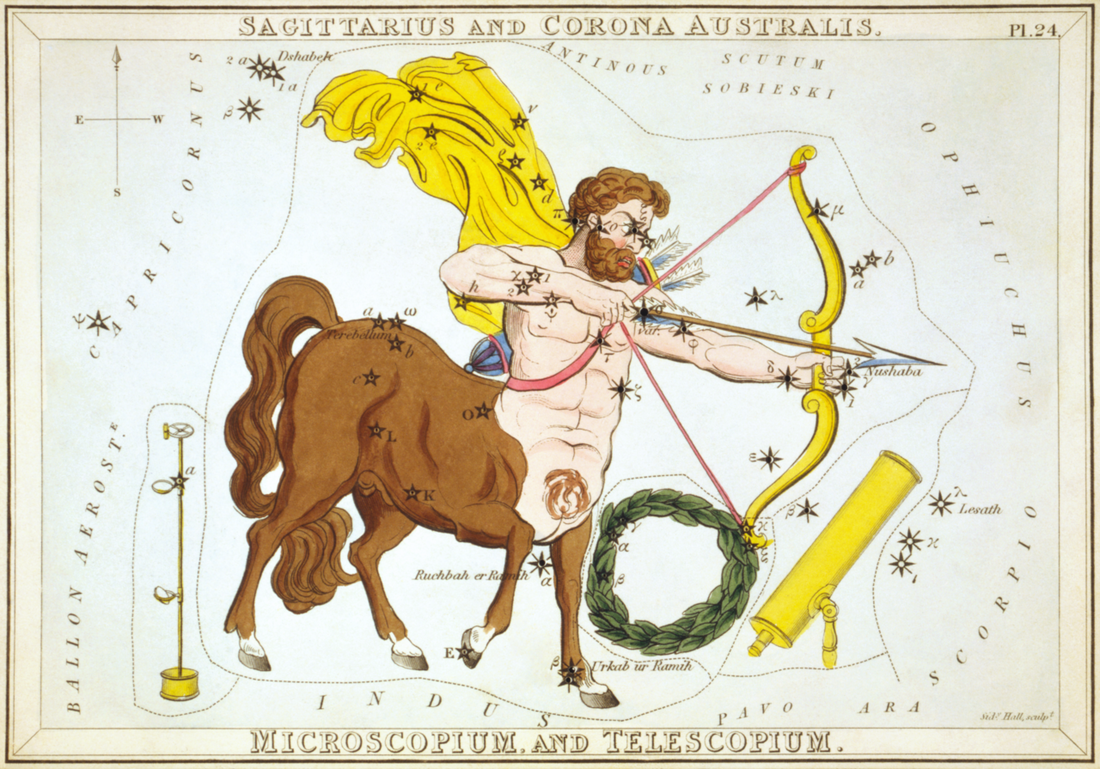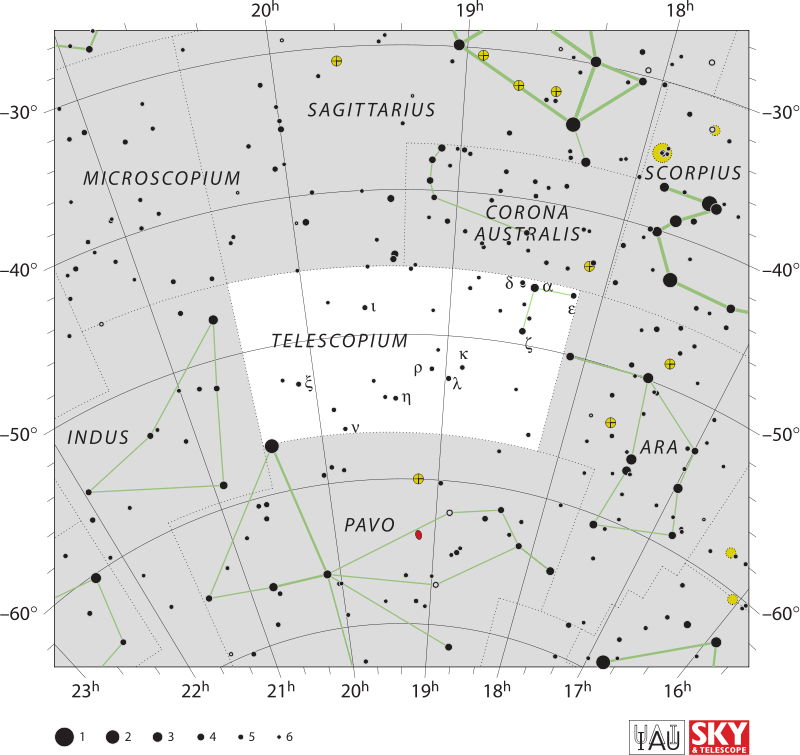|
One of the twelve constellations designated in the 18th century by French astronomer Nicolas-Louis de Lacaille, the Telescopium is a small constellation in the southern celestial hemisphere. It is one of the numerous constellations that show scientific instruments. The Latinized version of the Greek word for telescope serves as its name. Later, Francis Baily and Benjamin Gould reduced the size of the Telescopium.
Alpha Telescopii, a blue-white subgiant star with an apparent brightness of 3.5, is the brightest star in the constellation. Zeta Telescopii, an orange giant star with an apparent magnitude of 4.1, is the next brightest star. Two young star systems with brown dwarf partners and debris discs are Eta and PZ Telescopii. Two odd stars in Telescopium that have extraordinarily little hydrogen in them are most likely the consequence of two merging white dwarfs: While RS Telescopii is an R Coronae Borealis variable, PV Telescopii, also known as HD 168476, is a hot blue extreme helium star. A catastrophic variable known as RR Telescopii brightened to magnitude six as a nova in 1948. Additionally, QV Telescopii (HR 6819), a variable star with a magnitude of 5.32 to 5.39, is the first observable star system with a black hole known to exist. |
|
History
Nicolas-Louis de Lacaille first coined the term "Telescopium" in 1751–1752 under the moniker "le Telescope," which features an aerial telescope. This was after he had viewed and recorded 10,000 southern stars throughout a two-year sojourn at the Cape of Good Hope. In unexplored areas of the Southern Celestial Hemisphere that were obscured from Europe, he created fourteen new constellations. All but one of them recognised the tools of the Age of Enlightenment. The telescope (Wagman 2003) extended northward between Sagittarius and Scorpius, (Wagman 2003) spanning 40 degrees of the night sky. By 1763, Lacaille had changed the name to Telescopium in Latin. |
Other names for the constellation exist. In the eighteenth century, it was known as Tubus Astronomicus, and during that time, two of the three constellations that represent telescopes were recognised: Tubus Herschelii Minor between Taurus and Orion and Tubus Herschelii Major between Gemini and Auriga, both of which had become extinct by the nineteenth century. (Ellis 1997) In his 1805 Gestirne, Johann Bode referred to it as the Astronomische Fernrohr and left its borders as they were; however, astronomers Francis Baily and Benjamin Gould eventually reduced them. (Allen 1963) Several brighter stars were lost by the severely diminished constellation to nearby constellations: Gamma was placed in Scorpius and dubbed G Scorpii by Gould, Theta Telescopii returned to its previous name of d Ophiuchi, Sigma Telescopii was placed in Corona Australis, and Beta Telescopii became Eta Sagittarii, which it had been before Lacaille placed it in Telescopium. The latter was originally uncatalogued and is now known as HR 6875. Gould used the Bayer designation for a magnitude five star that he believed merited a letter; the original object Lacaille had designated Eta Telescopii—the open cluster Messier 7—was in what is now Scorpius. (Wagman 2003)
Characteristics
Telescopium, a minor constellation, is bounded to the north by Sagittarius and Corona Australis, to the west by Ara, to the south by Pavo, to the east by Indus, and to the northeast by Microscopium. The International Astronomical Union chose "Tel" as the constellation's three-letter designation in 1922. (Russell 1922) A quadrilateral serves as the formal delineation of the constellation borders, as established by Belgian astronomer Eugène Delporte in 1930. These borders' right ascension values in the equatorial coordinate system range from 18h 09.1m to 20h 29.5m, while their declination coordinates fall between 45.09° and 56.98°. In the south of latitude 33°N, observers can see the entire constellation.
The first observable star system with a black hole is found in Telescopium. The triple star system QV Telescopii, commonly known as HR 6819, is visible to the unassisted eye as a variable star with an apparent magnitude ranging from 5.32 to 5.39. The Telescopium is situated close to the SW corner with Ara and Pavo. Two B-type massive stars, the inner with the spectral type B3III and the outer Be, as well as one undiscovered stellar-mass companion in the inner pair with an orbital period of 40.33 days make up the hierarchical triple star system. It is assumed that this invisible partner is a non-accreting stellar-mass black hole with a mass of at least 4 M. As of 2020, QV Telescopii, the only known observable star system with a black hole, is the closest known black hole to Earth, located at about 1,120 light-years. (Rivinius 2020)
Telescopium, a minor constellation, is bounded to the north by Sagittarius and Corona Australis, to the west by Ara, to the south by Pavo, to the east by Indus, and to the northeast by Microscopium. The International Astronomical Union chose "Tel" as the constellation's three-letter designation in 1922. (Russell 1922) A quadrilateral serves as the formal delineation of the constellation borders, as established by Belgian astronomer Eugène Delporte in 1930. These borders' right ascension values in the equatorial coordinate system range from 18h 09.1m to 20h 29.5m, while their declination coordinates fall between 45.09° and 56.98°. In the south of latitude 33°N, observers can see the entire constellation.
The first observable star system with a black hole is found in Telescopium. The triple star system QV Telescopii, commonly known as HR 6819, is visible to the unassisted eye as a variable star with an apparent magnitude ranging from 5.32 to 5.39. The Telescopium is situated close to the SW corner with Ara and Pavo. Two B-type massive stars, the inner with the spectral type B3III and the outer Be, as well as one undiscovered stellar-mass companion in the inner pair with an orbital period of 40.33 days make up the hierarchical triple star system. It is assumed that this invisible partner is a non-accreting stellar-mass black hole with a mass of at least 4 M. As of 2020, QV Telescopii, the only known observable star system with a black hole, is the closest known black hole to Earth, located at about 1,120 light-years. (Rivinius 2020)
Deep-sky Objects
Main stars - 2
Bayer stars - 13
Stars with planets - 0
Stars brighter than magnitude 3.00 - 0
Stars within 32 Ly - 2
Messier objects - 0
Bordering
constellations
- Telescopium Group – Group of twelve galaxies
- NGC 6868 – Elliptical Galaxy
- NGC 6861 – Spiral/ lenticular Galaxy
- NGC 6584 – Globular Cluster
- IC 4889 – Elliptical Galaxy
- NGC 6845 – Group of four galaxies interacting with each other.
Main stars - 2
Bayer stars - 13
Stars with planets - 0
Stars brighter than magnitude 3.00 - 0
Stars within 32 Ly - 2
Messier objects - 0
Bordering
constellations
- Ara
- Corona Australis
- Indus
- Microscopium
- Pavo
- Sagittarius


